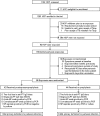A comparison of 2 strategies to prevent infection following pertussis exposure in vaccinated healthcare personnel
- PMID: 22238169
- PMCID: PMC3297652
- DOI: 10.1093/cid/cir973
A comparison of 2 strategies to prevent infection following pertussis exposure in vaccinated healthcare personnel
Abstract
Background: Antibiotic postexposure prophylaxis (PEP) following pertussis exposure is recommended but has never been evaluated in healthcare personnel (HCP) vaccinated with acellular pertussis vaccine (Tdap).
Methods: Tdap-vaccinated HCP were randomized to receive azithromycin PEP or no PEP following pertussis exposure. Acute and convalescent nasopharyngeal swabs and sera were obtained for pertussis testing by polymerase chain reaction (PCR) and anti-pertussis toxin (PT) immunoglobulin G, respectively. A nasopharyngeal aspirate was also collected for PCR and culture from subjects who reported respiratory symptoms within 21 days following identification of the exposure. Pertussis infection was defined as a positive culture or PCR, a 2-fold rise in anti-PT titer, or a single anti-PT titer of ≥94 enzyme-linked immunosorbent assay units/mL. Daily symptom monitoring without PEP was considered noninferior to PEP after pertussis exposure if the lower limit of the 1-sided 95% confidence interval (CI) for the reduction in pertussis was greater than -7%.
Results: During 30 months of study, 86 subjects were randomized following a pertussis exposure. Using the predefined definition of infection, pertussis infection did not develop in 41 (97.6%) of 42 subjects who received azithromycin PEP and 38 (86.4%) of 44 subjects who did not receive PEP (absolute risk difference, -11.3%; lower bound of the 1-sided 95% CI, -20.6%; P = .81). However, no subject developed symptomatic pertussis confirmed with culture or a specific PCR assay, and possibly no subject developed subclinical pertussis infection based upon additional serologic testing.
Conclusions: Using the predefined definition of pertussis infection, noninferiority for preventing pertussis following exposure was not demonstrated for daily symptom monitoring of Tdap-vaccinated HCP without PEP when compared with antibiotic PEP. However, the small number of exposed HCP warrants further study of this approach.
Clinical trial registration: NCT00469274.
Figures

Similar articles
-
Sustained efficacy during the first 6 years of life of 3-component acellular pertussis vaccines administered in infancy: the Italian experience.Pediatrics. 2001 Nov;108(5):E81. doi: 10.1542/peds.108.5.e81. Pediatrics. 2001. PMID: 11694665 Clinical Trial.
-
A genetically inactivated two-component acellular pertussis vaccine, alone or combined with tetanus and reduced-dose diphtheria vaccines, in adolescents: a phase 2/3, randomised controlled non-inferiority trial.Lancet Infect Dis. 2018 Jan;18(1):58-67. doi: 10.1016/S1473-3099(17)30612-6. Epub 2017 Oct 20. Lancet Infect Dis. 2018. PMID: 29066131 Clinical Trial.
-
Safety and immunogenicity of a combined Tetanus, Diphtheria, recombinant acellular Pertussis vaccine (TdaP) in healthy Thai adults.Hum Vaccin Immunother. 2017 Jan 2;13(1):136-143. doi: 10.1080/21645515.2016.1234555. Epub 2016 Sep 29. Hum Vaccin Immunother. 2017. PMID: 27686283 Free PMC article. Clinical Trial.
-
Reduced-antigen, combined diphtheria, tetanus and acellular pertussis vaccine, adsorbed (Boostrix®): a review of its properties and use as a single-dose booster immunization.Drugs. 2012 Sep 10;72(13):1765-91. doi: 10.2165/11209630-000000000-00000. Drugs. 2012. PMID: 22931522 Review.
-
Acellular pertussis vaccine use in risk groups (adolescents, pregnant women, newborns and health care workers): a review of evidences and recommendations.Vaccine. 2012 Jul 27;30(35):5179-90. doi: 10.1016/j.vaccine.2012.06.005. Epub 2012 Jun 15. Vaccine. 2012. PMID: 22709953 Review.
Cited by
-
Postexposure management of healthcare personnel to infectious diseases.Hosp Pract (1995). 2015;43(2):107-27. doi: 10.1080/21548331.2015.1018091. Epub 2015 Mar 1. Hosp Pract (1995). 2015. PMID: 25728206 Free PMC article.
-
Does working in hospital increases seroprevalence and carrier state against Bordetella pertussis?Adv Biomed Res. 2015 Sep 28;4:194. doi: 10.4103/2277-9175.166155. eCollection 2015. Adv Biomed Res. 2015. PMID: 26605233 Free PMC article.
-
Azithromycin to Prevent Pertussis in Household Contacts, Catalonia and Navarre, Spain, 2012-2013.Emerg Infect Dis. 2020 Nov;26(11):2678-2684. doi: 10.3201/eid2611.181418. Emerg Infect Dis. 2020. PMID: 33079034 Free PMC article.
-
Atypical Presentation of Bordetella pertussis in a Six-Month-Old with Cleaved Lymphocytes and Mild Respiratory Distress.Cureus. 2025 Jun 5;17(6):e85395. doi: 10.7759/cureus.85395. eCollection 2025 Jun. Cureus. 2025. PMID: 40621272 Free PMC article.
-
Prevention of Pertussis, Tetanus, and Diphtheria with Vaccines in the United States: Recommendations of the Advisory Committee on Immunization Practices (ACIP).MMWR Recomm Rep. 2018 Apr 27;67(2):1-44. doi: 10.15585/mmwr.rr6702a1. MMWR Recomm Rep. 2018. PMID: 29702631 Free PMC article.
References
-
- CDC. Preventing tetanus, diphtheria, and pertussis among adults: use of tetanus toxoid, reduced diphtheria toxoid and acellular pertussis vaccine recommendations of the Advisory Committee on Immunization Practices (ACIP) and recommendation of ACIP, supported by the Healthcare Infection Control Practices Advisory Committee (HICPAC), for use of Tdap among health-care personnel. MMWR Recomm Rep. 2006;55:1–37. - PubMed
-
- Deville JG, Cherry JD, Christenson PD, et al. Frequency of unrecognized Bordetella pertussis infections in adults. Clin Infect Dis. 1995;21:639–42. - PubMed
-
- Wright SW, Decker MD, Edwards KM. Incidence of pertussis infection in healthcare workers. Infect Control Hosp Epidemiol. 1999;20:120–3. - PubMed
-
- De Serres G, Shadmani R, Duval B, et al. Morbidity of pertussis in adolescents and adults. J Infect Dis. 2000;182:174–9. - PubMed
-
- Baggett HC, Duchin JS, Shelton W, et al. Two nosocomial pertussis outbreaks and their associated costs—King County, Washington, 2004. Infect Control Hosp Epidemiol. 2007;28:537–43. - PubMed
Publication types
MeSH terms
Substances
Associated data
Grants and funding
LinkOut - more resources
Full Text Sources
Other Literature Sources
Medical
Miscellaneous

